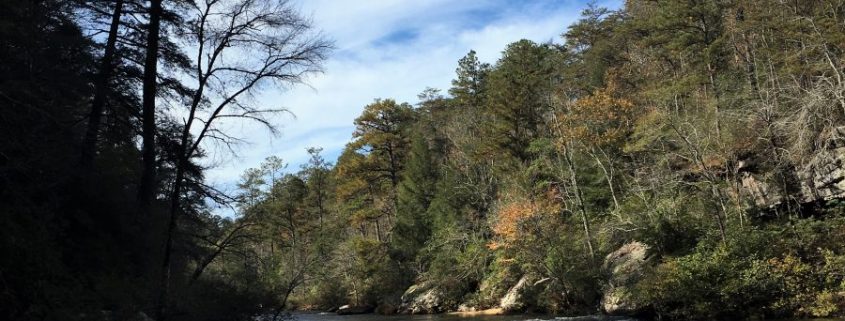Mid-November Camp McDowell Land Legacy Orientation
Camp McDowell invited me to visit November 15 & 16, 2018. Our purpose — to explore developing a Camp McDowell and Conference Center Land Legacy Story for the 1,140 acre property. In operation on-site since 1947, this Winston County treasure “shows the way the world could be through worship, learning, rest and play in the beauty of God’s Backyard.” McDowell is “the Camp and Conference Center for the Episcopal Church in the Diocese of Alabama. We are also home to the Alabama Folk School, McDowell Environmental Center, and the McDowell Farm School.”
The property sits smack dab in the midst of the Bankhead National Forest’s 181,000 acres. I’m astounded that these 283 square miles of exquisite forestland came to the Forest Service under the movement 125 years ago to deal with and manage the huge swaths of abandoned and spent eastern forestland (as well as abandoned farms) referred to broadly as the lands nobody wanted. I drove through miles of the Bankhead as I headed south to McDowell. I’m a softy for unbroken forest. Only someone as I, familiar with the eastern National Forests and their history, along with my perception of the roadside forest as even-aged, second-growth, would see this unbroken cover as anything but forest primeval.
Some might say, “How boring; there is nothing to see!” Au contraire, this was heaven to my appreciative professional forester’s eyes! Rolling hills of mature pine and mixed hardwood forest… some thinned, some periodically burned to control understory vegetation. The Camp McDowell entrance sign appeared as I was still appreciating and admiring the forests.

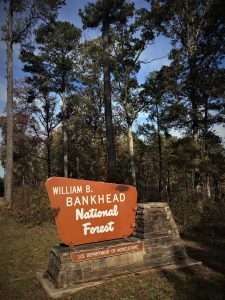
Nourishing Body, Mind, Heart, Soul, and Spirit
I’ve visited McDowell a half-dozen times over the past couple of years, first as guest of then McDowell Director Mark Johnston and Environmental Education Center Director Maggie Johnston. The St. Francis Chapel is emblematic of the Camp’s devotion to Faith, Nature, and the future. What better lens to view the Chapel than the dawn’s first rays of sun on a frosty mid-November morning.
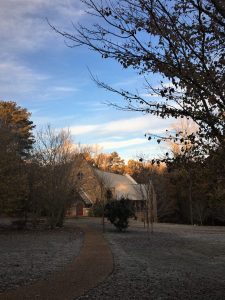
McDowell greeted my Thursday morning arrival with a dusting of snow and 30-degree temperature.
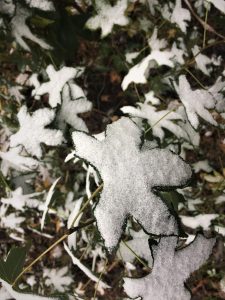
I stayed overnight this most recent time at the far lodge above Sloan Lake (lower left photo). A perfect setting to appreciate the Camp. The day remained cloudy, breezy, and unseasonably cold, never reaching 40. The average daily high for the date is low 60s. I have not confirmed that we set a record low high temperature for the date; I am sure we at least approached a new record. Lakes, streams, and falling leaves don’t mind the early cold. People complain a bit. After an uncommonly warm September and October, I saw the chill as overdue, and found joy in the November look and feel of the day.
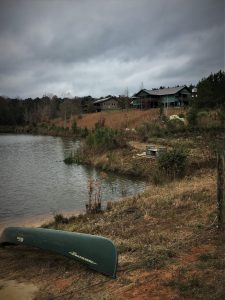
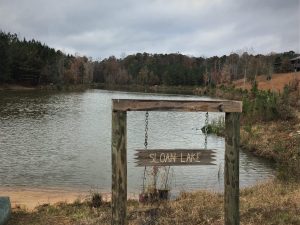
McDowell tugs at my heart. When in this extraordinary Natural setting, I engage with the place, its mission, its staff, the campers, and spirituality with all five of my life-portals: mind, body, heart, soul, and spirit. The whole is so much greater than the sum of its parts. McDowell reignites some fundamental tenets and principles that guide my life and profession. I want to make some small corner of this world better through wisdom, knowledge, and hard work. Perhaps McDowell is one element of that small corner I can influence.
The Eppes Dining Hall at the Environmental Camp along Clear Creek fed some 200 fifth and sixth graders (and their teachers/chaperones) Thursday evening. Participants are fully engaged and totally immersed in Nature’s wonders.
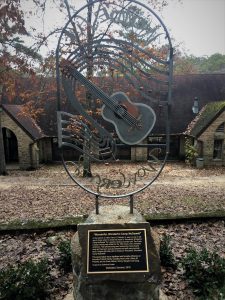
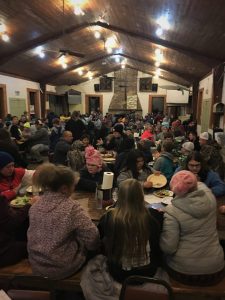
I saw lots of places in the Camp core for relaxing and reflecting. Each special location has its story — memories, donors, and wisps of history and meaning. Even as these infrastructure elements tell a tale, the surrounding wildness and Nature have legacy components awaiting exploration, interpretation, and translation… leading to developing McDowell’s comprehensive Land Legacy Story. I would welcome a chance to memorialize McDowell’s Story. I want to help McDowell translate the record written in the land and forests, combine it with key interviews of current and past players, and add bits of history residing in available archives, including old photographs (aerial and land-based), and individual recollections. Oh, if only we could literally wander back in time.
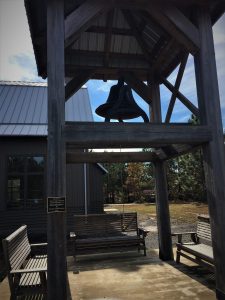
When would have been the ideal time to begin weaving the story? Perhaps 1847, one hundred years prior to McDowell’s formal on-site beginning. Or, if only the Clear Creek rock ledges could talk!
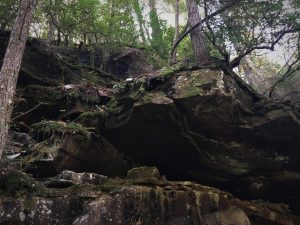
Or the massive loblolly pine (flanked by former Camp Director Mark Johnston) along Clear Creek at Tiller’s Beach. This magnificent specimen (yes, the tree!) likely stood there in 1847 as a sapling.
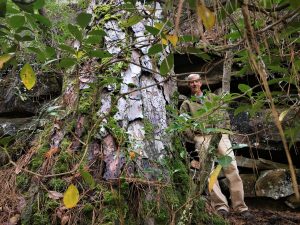
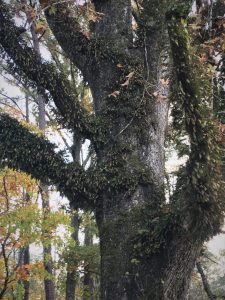
Or the resurrection fern-festooned oak that shaded the front yard of a long-since gone farm house or outbuilding along the Camp entrance road near the current Camp store. The oak certainly predates the Camp’s origins and may have been planted in the late 19th century. I wonder when the first fern sprouted from the now deeply-furrowed bark. Think about how appropriate it would have been if the first floral resurrection occurred in 1947! In effect, its sprouting could symbolize “the way the world could be through worship, learning, rest and play in the beauty of God’s Backyard.” Here was Camp McDowell rising from an old worn out farm in the midst of 283 square miles of the lands nobody wanted! We can core the oak with an increment borer to determine the tree’s age. Dating the fern’s appearance will take the luck of a chance photo from the Camp’s early days.
If only we had begun detailed chronicling of McDowell’s natural components in 1947. Yet we really cannot begin such deliberate and detailed monitoring and record keeping until now. And begin we must. Who among future campers in 2118, 100 hundred years hence, wouldn’t enjoy seeing the Camp’s first solar photo-voltaic panels? A literal example of “Harnessing Nature’s Power”!
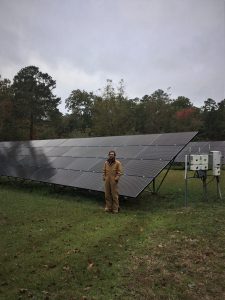
Who would not appreciate seeing the November 17, 2018 sun rising from behind the barn, illuminating a frosted field? Or seeing the Farm School pigs relishing the mud within their enclosure?
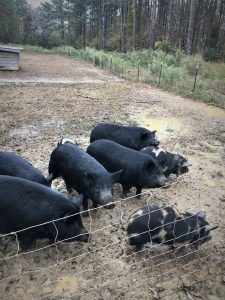
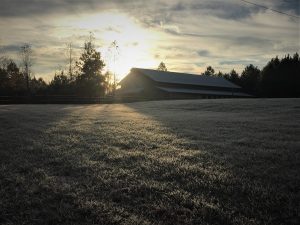
Imagine a permanent photo point capturing this view to the north from the embankment along the beaver pond dam? A snap shot repeated routinely every ten years demonstrating changes the 2118 fifth grader can observe back through time.
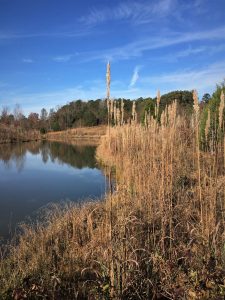
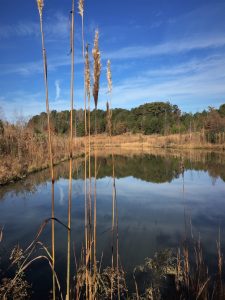
What might a permanent ten-year-interval photographic record reveal from Tiller’s Beach? Here are Friday’s view upstream (left) and downstream (with former Camp Director Mark Johnston contemplating the view and reflecting on his five decade love affair with McDowell, beginning with student seasonal engagement). Mark is among those who can fill voids and inform the Land Legacy Story. There are others (in addition to Mark) we must transport virtually via the Legacy Tale to 2118 and beyond. If only I could bottle the elixir-essence of our November 2018 morning stroll along Clear Creek.
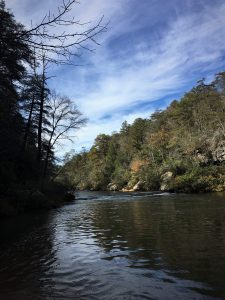
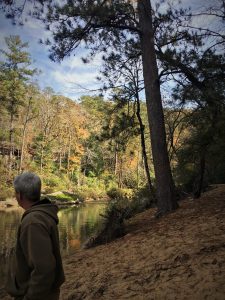
Special Vegetation
How many tree and shrub species does McDowell host? No one I asked in mid-November knew the answer or could recall seeing a species inventory. I’m hoping that over the Camp’s 71 years some intrepid botanist has assembled such a list. Legacy Story research will entail scrubbing the archives to rediscover such a list. If one does not exist, developing the inventory will fall to my Land Legacy Story recommendations section.
Longleaf pine is one of my favorite Alabama trees. It’s one of the state’s ten native pines. How many others of those ten are on-site? I saw loblolly, Virginia, and shortleaf pines as Mark and I hiked several trails Friday morning. Mark and associates planted hundreds (thousands?) of longleaf seedlings on cleared land surrounding the beaver pond and at other locations on the property. I was surprised to see direct evidence that the intrepid pond rodents harvested the sticky sap-rich saplings (chewed-off stump in foreground lower left). Easy to see how longleaf earned its moniker (standing tree lower left and the dense foliage lower right).
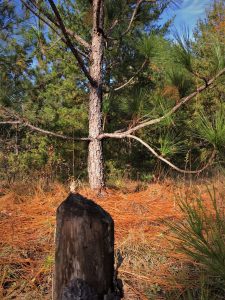
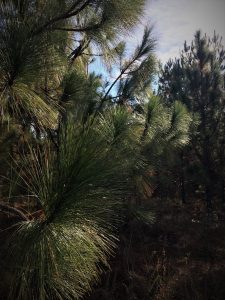
That’s Mark’s hand (for scale) on a Tiller’s Beach farkleberry (Vaccinium arboreum). Another common name: sparkleberry. It’s the only tree-form member of the blueberry genus. Its deep black fruit shines and sparkles this time of year; the term farkle implies a combination of sparkle and function. According to The Flora of North America, “Sparkleberry grows on sand dunes, hammocks, dry hillsides, meadows, and in rocky woods. It also grows on a variety of moist sites such as wet bottomlands and along creek banks.” This specimen occupies a sand bar site moistened from within the sandy soil by Clear Creek seepage.
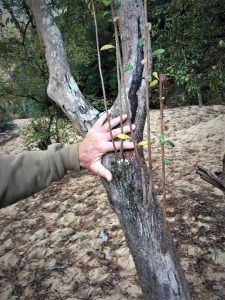
According to the Missouri Botanical Garden, bigleaf magnolia (Magnolia macrophylla) “is noted for its huge oblong-obovate leaves (to 30 inches long) which are the largest simple leaves of any tree indigenous to North America. Leaves are green above and silvery-gray below. This unusual tree is rarely found in the wild, being limited mainly to a few rich wooded areas in river valleys and ravines in the southeastern United States.” Carolina Nature describes bigleaf magnolia as a “rare deciduous native.” I saw nothing rare about bigleaf magnolia at McDowell. I’ve never seen such abundance in my travels across its range. By the time I departed Friday afternoon, most leaves had fallen. Thursday morning some trees still held fast to their yellowing leaves (lower left). My boot (size 12!) gives some sense of leaf scale. Oddly, nearly all leaves fell top-side down. A mystery for another day. A future assignment for Environmental Camp sixth-graders?

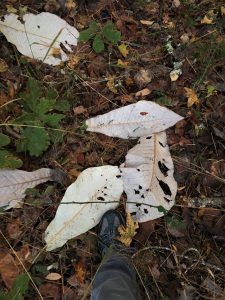
I couldn’t get over the impressive leaf size — the longest on the sofa below is 26-inches! So, on-site during those two days, we discovered individuals of the only tree-form blueberry (genus Vaccinium), North America’s longest-leafed indigenous tree species, and one of Alabama’s largest loblolly pines (record is ~4.5-feet diameter). McDowell’s Story begs to be told!
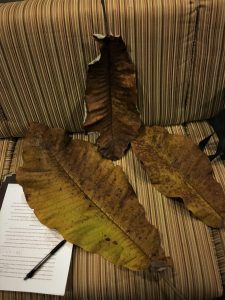
We encountered a willowlike-leaf shrub in what I at first surmised was in full flower along roads and field edges. No one I asked could identify it. When I originally posted this essay November 27, I noted, “I am still investigating. I suspect it is an invasive. Because it is so common and spectacularly showy for the season, it is worthy of a mid-November floral highlight for one of the state’s premier environmental education centers. Just another component of the Camp’s Land Legacy Story, which is both a look back… and a careful and deliberate view ahead identifying needs critical to Camp relevance and excellence.” Today, December 5, 2018, with the help of Cane Creek Canyon’s Jim Lacefield, we have identified the shrub as groundsel-tree (Baccharis halimifolia). How on earth did I not properly identify this species that is native to North America from Massachusetts south to Florida and Texas!? I admit total embarrassment. Once Jim led me to identification, I revisited my photographs. What I mistook (sloppily) as flowers were in fact seed heads, the silky seed appearing to my lazy examination as flowers. A big wake-up lesson for me — I sat for far too long in my higher education executive offices, growing dull in my field skills. I pledge to be more diligent, systematic, and persistent — to pay attention to field tools lost to pencil-pushing!
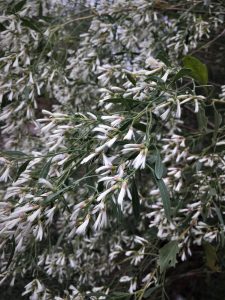
Now, what about the non-tree and shrub flowering plants — a McDowell inventory? My favorite paintings look like photographs (Yes, I am a man of simple tastes); my favorite photos look like paintings. Nature’s frosty brush painted the Friday morning image below. Sedges and goldenrod, frosted pine seedlings, and foreground frost-silvered grass with mixed fall hardwoods providing background. A nice painting!
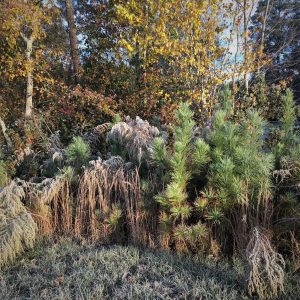
I’m a sucker for bark encrusted with non-flowering plants. An admirable moss community coats the Virginia pine stem (lower left); lichen adds a nice pattern to the otherwise slate grey of the American beech near the lodge where I stayed. Nature tolerates no vacuums in these well-watered southern temperate forests. Do the Camp archives contain inventories of McDowell non-flowering plants — ferns, mosses, lichens, fungi?

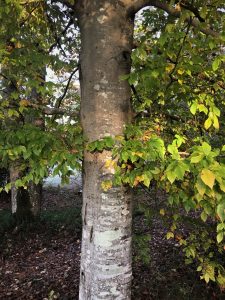
Harnessing Nature’s Wisdom, Inspiration, and Power through Knowledge and Recognition
Even something as simple as a weathered fence rail can inspire. Soaking rain, transitioning to snow before ending Thursday dawn, had saturated the wood. Friday morning’s 24 degrees drew frost-sickles from the wood… a hoar frost decoration. Add in remnant snow around the old knothole, and the adornment is complete (lower right). Nature’s beauty, magic, wonder, and awe are wherever we choose to seek and discover. The rewards are ours!
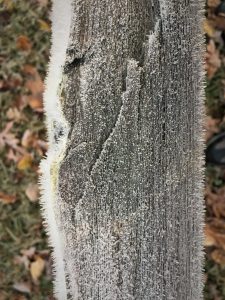
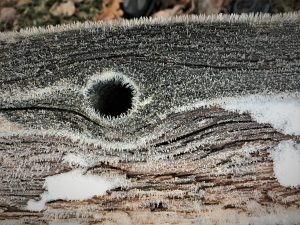
A frosty field and a leaf-strewn woods path at dawn soothe the soul and elevate the spirit. McDowell’s Nature portfolio begins fresh with every new day.
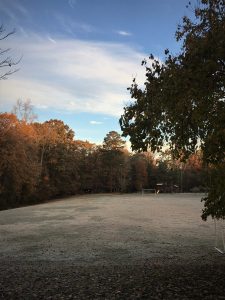
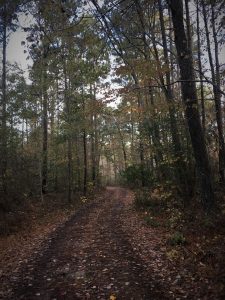
This dawn photo epitomizes the spirit, promise, and hope of a new day in God’s Backyard.
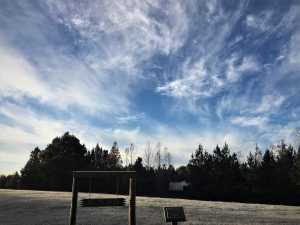
And, again, the Chapel symbolizes “the way the world could be through worship, learning, rest and play” in Nature.
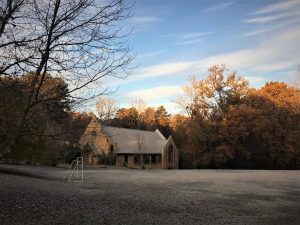
Even if my mid-November McDowell visit does not lead to preparing the Camp and Conference Center’s Land Legacy Story, I will have lived richly in McDowell’s inspired glow for two days. Whether I compile the Story or not, the tale will remain within the land. Every parcel has a Story. Camp McDowell has touched and changed lives for seven decades… thousands of lives. Its Land Legacy Story is all the more powerful owing to the Camp’s mission and cause in service to humanity. If asked to proceed, I would accept the challenge with great humility, and a heartfelt gratitude for a chance to make a positive difference for tomorrow. I would seek inspiration from the mission, the land, and the people who lead (and led) the way.

What an honor and privilege it would be. My efforts would be purpose-driven and passion-fueled. I believe in the noble cause that guides McDowell.
Thoughts and Reflections
I may offer nothing new to Camp McDowell. Sure, I see the 1,140 acres through a composite lens comprising a bachelors in forestry, a doctorate in applied ecology, lifelong Nature enthusiasm, former industrial forestry practice, 35 years in higher education, four university presidencies, author, speaker, and advocate for Nature’s lessons for Life and Living. I believe earnestly in McDowell’s commitment to enable people young and old to employ five essential verbs:
- BELIEVE that all of Nature’s wisdom and power are hidden within plain view
- LOOK with intent beneath the superficial; LOOK deeply without the distractions that too often obstruct vision
- SEE what lies hidden within
- SEE deeply enough to evoke emotion; that is… FEEL
- FEEL acutely enough to inspire and stir ACTion… ACT to make tomorrow brighter
Although these are my five verbs, I see them implied in all that McDowell does. The Environmental Center mission “is to connect people to the environment, teach respect for the Earth and its beings, and to promote a commitment to lifelong learning.” I watched the Camp in action in form of a Thursday evening Radical Raptors program at the Chapel. I did not need to reach far to witness my five verbs in practice.
The Environmental Center flier states its role clearly: To provide “an experience impossible to find in a classroom. Students are taught by seeing nature up close: wading into a stream to catch invertebrates, touching sandstone canyon walls, identifying trees using a dichotomous key, and solving group challenges with their teammates. While creating self-confidence, students explore the outdoors firsthand, building lifelong awareness and respect for the natural world.”
May Nature inspire all that you do!
Note: All blog post images created & photographed by Stephen B. Jones unless otherwise noted. Please circulate images with photo credit: “©2018 Steve Jones, Great Blue Heron LLC. All Rights Reserved.”
Another Note: If you came to this post via a Facebook posting or by an another route, please sign up now (no cost… no obligation) to receive my Blog Post email alerts: https://stevejonesgbh.com/contact/
And a Third: I am available for Nature-Inspired Speaking, Writing, and Consulting — contact me at steve.jones.0524@gmail.com

